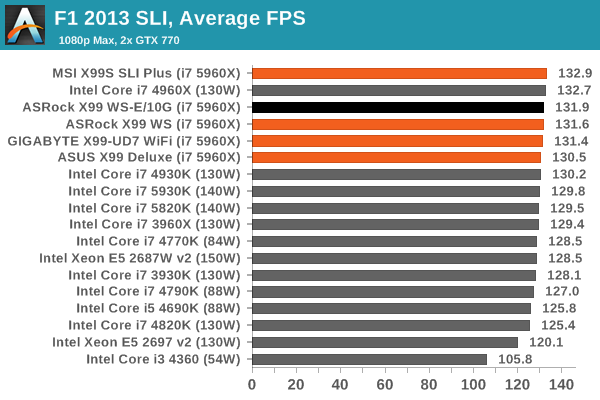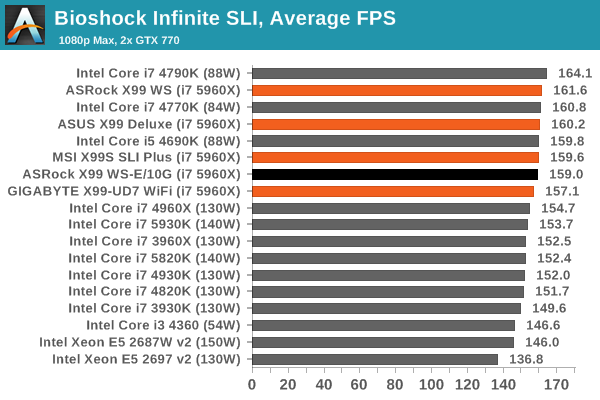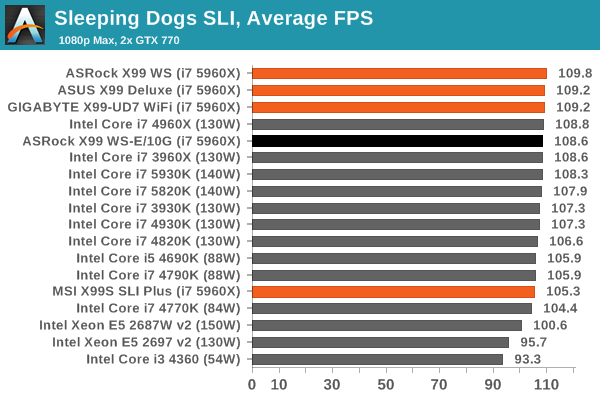ASRock X99 WS-E/10G Motherboard Review: Dual 10GBase-T for Prosumers
by Ian Cutress on December 15, 2014 10:00 AM EST- Posted in
- Motherboards
- IT Computing
- Intel
- ASRock
- Enterprise
- X99
- 10GBase-T
Gaming Performance
An interesting point to consider is the addition of the PLX8747 chips to allow for x16/x16/x16/x16 PCIe layouts. In previous reviews we have noted that these chips barely reduce the frame rate if at all, however one could suggest that as the X99 WS-E/10G uses two of them (and we split our SLI testing cards between them), there might be more room for additional delays.
Ultimately however our results were within the same range as the other X99 motherboards, suggesting that PCIe bandwidth on this scale (1080p, max settings) is not affected. It would be interesting to see a three or four-way SLI setup powering several 4K monitors.
F1 2013
First up is F1 2013 by Codemasters. I am a big Formula 1 fan in my spare time, and nothing makes me happier than carving up the field in a Caterham, waving to the Red Bulls as I drive by (because I play on easy and take shortcuts). F1 2013 uses the EGO Engine, and like other Codemasters games ends up being very playable on old hardware quite easily. In order to beef up the benchmark a bit, we devised the following scenario for the benchmark mode: one lap of Spa-Francorchamps in the heavy wet, the benchmark follows Jenson Button in the McLaren who starts on the grid in 22nd place, with the field made up of 11 Williams cars, 5 Marussia and 5 Caterham in that order. This puts emphasis on the CPU to handle the AI in the wet, and allows for a good amount of overtaking during the automated benchmark. We test at 1920x1080 on Ultra graphical settings.

Bioshock Infinite
Bioshock Infinite was Zero Punctuation’s Game of the Year for 2013, uses the Unreal Engine 3, and is designed to scale with both cores and graphical prowess. We test the benchmark using the Adrenaline benchmark tool and the Xtreme (1920x1080, Maximum) performance setting, noting down the average frame rates and the minimum frame rates.

Tomb Raider
The next benchmark in our test is Tomb Raider. Tomb Raider is an AMD optimized game, lauded for its use of TressFX creating dynamic hair to increase the immersion in game. Tomb Raider uses a modified version of the Crystal Engine, and enjoys raw horsepower. We test the benchmark using the Adrenaline benchmark tool and the Xtreme (1920x1080, Maximum) performance setting, noting down the average frame rates and the minimum frame rates.

Sleeping Dogs
Sleeping Dogs is a benchmarking wet dream – a highly complex benchmark that can bring the toughest setup and high resolutions down into single figures. Having an extreme SSAO setting can do that, but at the right settings Sleeping Dogs is highly playable and enjoyable. We run the basic benchmark program laid out in the Adrenaline benchmark tool, and the Xtreme (1920x1080, Maximum) performance setting, noting down the average frame rates and the minimum frame rates.

Battlefield 4
The EA/DICE series that has taken countless hours of my life away is back for another iteration, using the Frostbite 3 engine. AMD is also piling its resources into BF4 with the new Mantle API for developers, designed to cut the time required for the CPU to dispatch commands to the graphical sub-system. For our test we use the in-game benchmarking tools and record the frame time for the first ~70 seconds of the Tashgar single player mission, which is an on-rails generation of and rendering of objects and textures. We test at 1920x1080 at Ultra settings.
















45 Comments
View All Comments
AngelosC - Wednesday, January 7, 2015 - link
They could have tested it on Linux KVM with SR-IOV or just run iperf on Linux between the 2 interfaces.They ruined the test.
eanazag - Monday, December 15, 2014 - link
Okay, so the use case of a board like this is for network attached storage using iSCSI or SMB3. That network storage has to be able to perform above 1GbE bandwith for a single stream. 1 GbE = ~1024 Mbps = ~128 MBps no counting overhead. Any single SSD these days can outperform a 1GbE connection.If you're considering this board, there is a Johan written article on Anand that is a couple of years old about 10GbE performance. It will cover why it is worth it. I did the leg work and found them.
http://www.anandtech.com/show/4014/10g-more-than-a...
http://www.anandtech.com/show/2956/10gbit-ethernet...
extide - Monday, December 15, 2014 - link
At the end of the day, I still think I'd rather the X99 Extreme 11.tuxRoller - Monday, December 15, 2014 - link
How Is the DPC measurement made? Average (which?), worst case, or just once?Ian Cutress - Tuesday, November 1, 2016 - link
Peak (worst value) during our testing period, which is usually a minute at 'idle'TAC-2 - Tuesday, December 16, 2014 - link
Either there's something wrong with your test of the NICs or there is a problem with this board. I've been using 10GBase-T for years now, even with default settings I can push 500-1000 MB/s using intel NICs.AngelosC - Wednesday, January 7, 2015 - link
I recon they were not testing this board's most important feature properly.The reviewer makes it sounds like they don't know how to test…
jamescox - Tuesday, December 16, 2014 - link
This seems more like a marketing thing; who will actually buy this? Given the current technology, it seems like it is much better to buy a discrete card, if you actually need 10GB.The feature I would like to see come down to the consumer market is ECC memory. I have had memory start to get errors after installation. I always run exhaustive memory test when building a system (memtest86 or other hardware specific test). I did not have any stability issues. I only noticed that something was wrong when I found that recently written files were corrupted. Almost everything passes through system memory at some point. Why is it okay for this not to be ECC protected? Given how far system memory is from the cpu (with L3 cache, and soon to be L4 with stacked memory), the speed is actually less important. Everything should be ECC protected.
There may be some argument that the gpu memory doesn't need to be ECC, since if it is just being used for display; errors will only result in display artifacts. I am not sure if this is actually the case anymore though with what gpus are being used for. Can a single bit error in gpu memory cause a system crash? I may have to start running gpu memory test also.
petar_b - Thursday, December 18, 2014 - link
ASROCK solely targets users with need of 10G network. If network card was an discrete option price would be lower and they would target wider audience. I like two PLXes, as I can attach all kind of Network, SAS and GPU cards. PLX and ASROCK quality is the reason I use their mobos.Regarding ECC memory for GPU, not agree there. If GPU is used to do math with OpenCL, then avoiding memory errors is very important.
akula2 - Thursday, December 18, 2014 - link
Avoiding memory errors is beyond extremely important in my case when I churn tons of Science and Engineering things out of those Nvidia Titan Black, Quadro and Tesla cards. AMD did an amazing job with FirePro W9100 cards too.